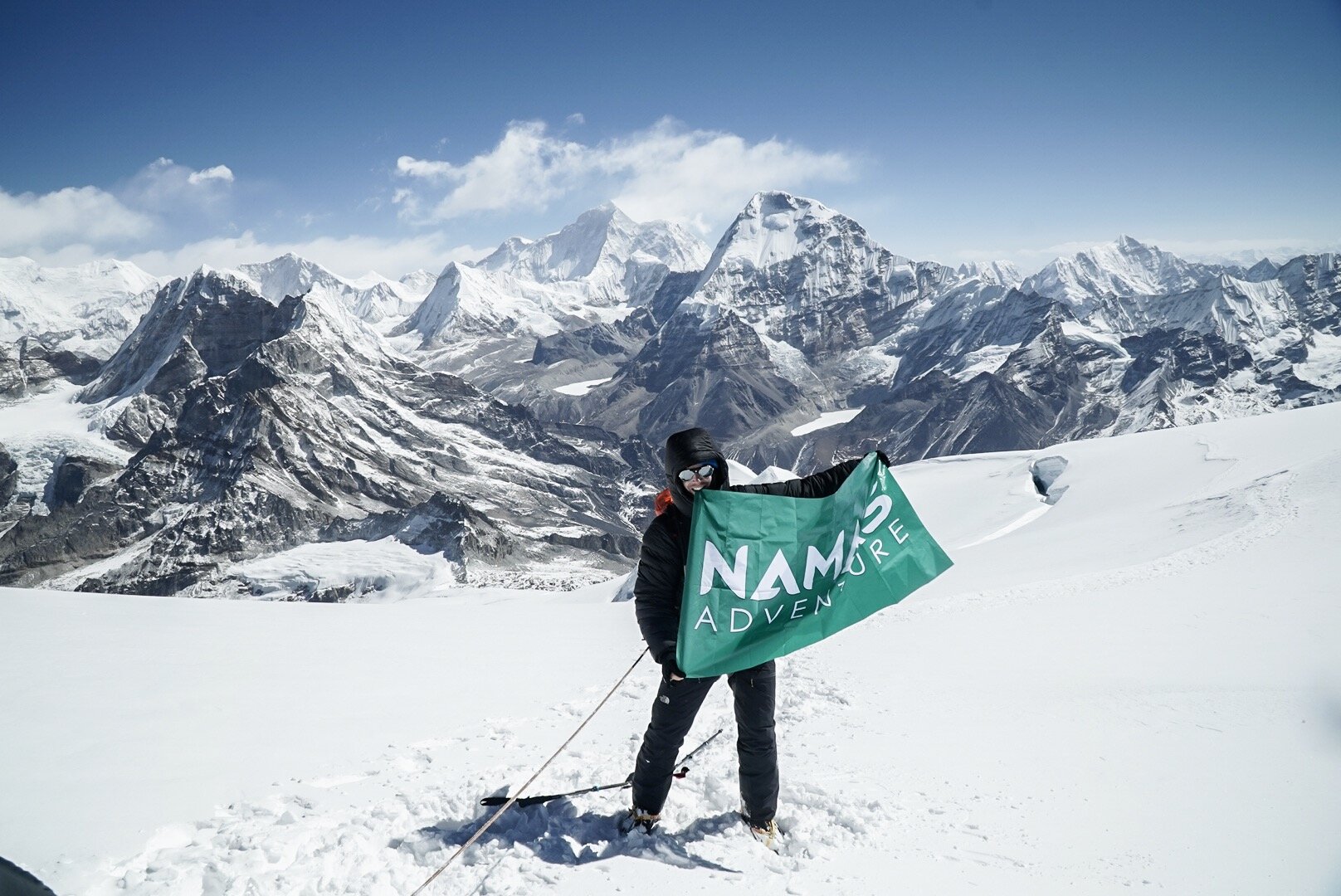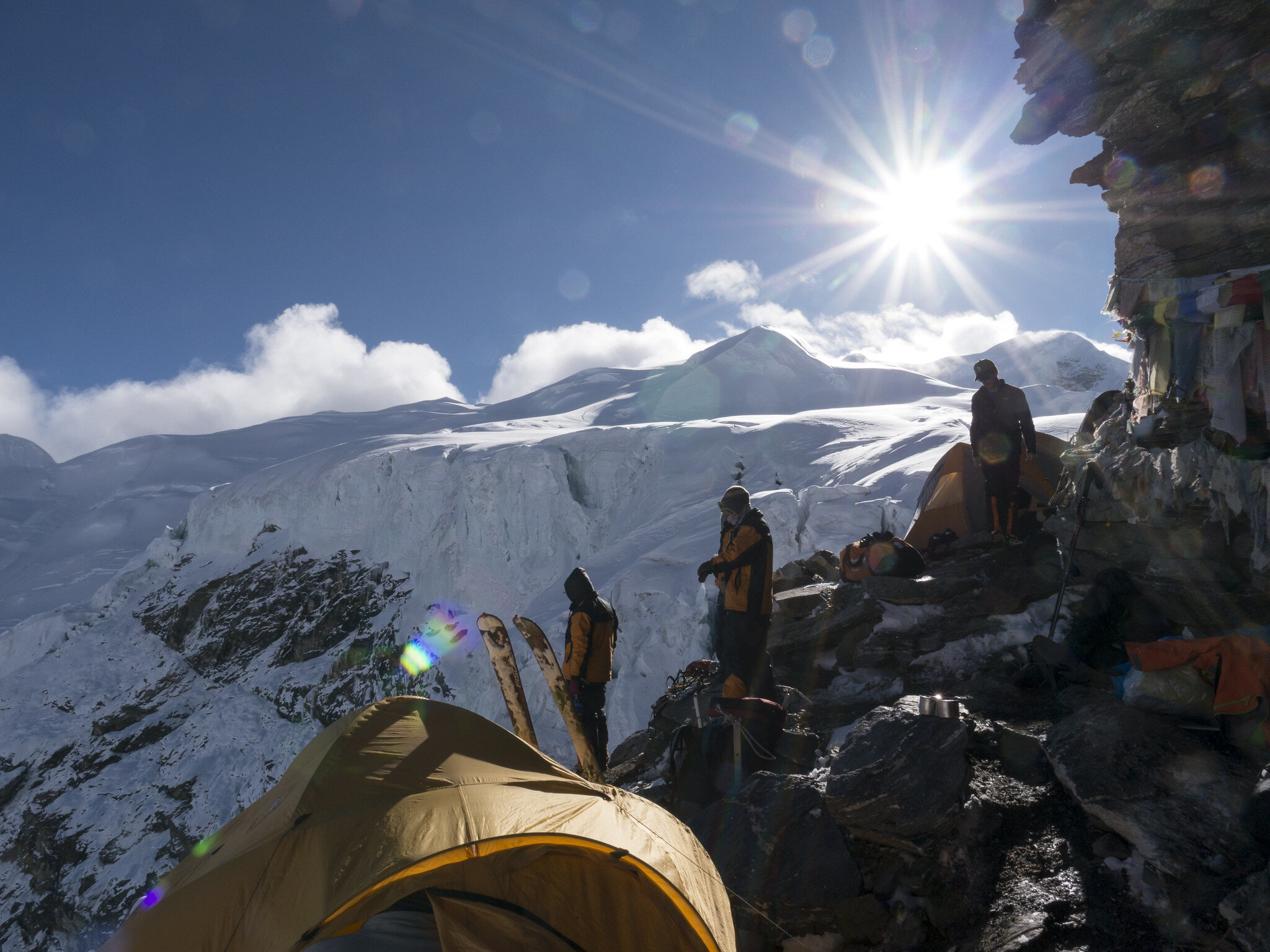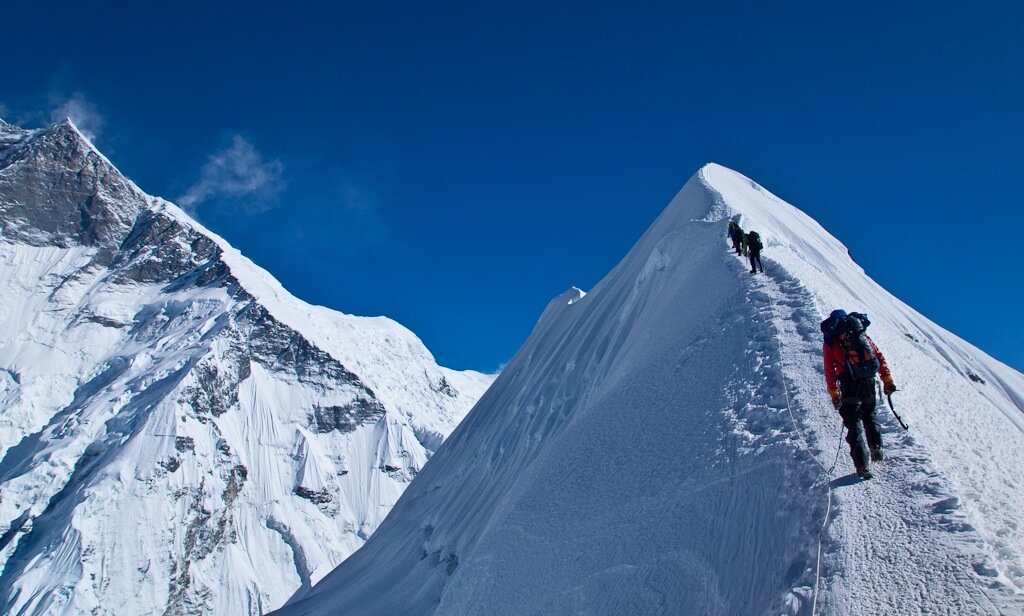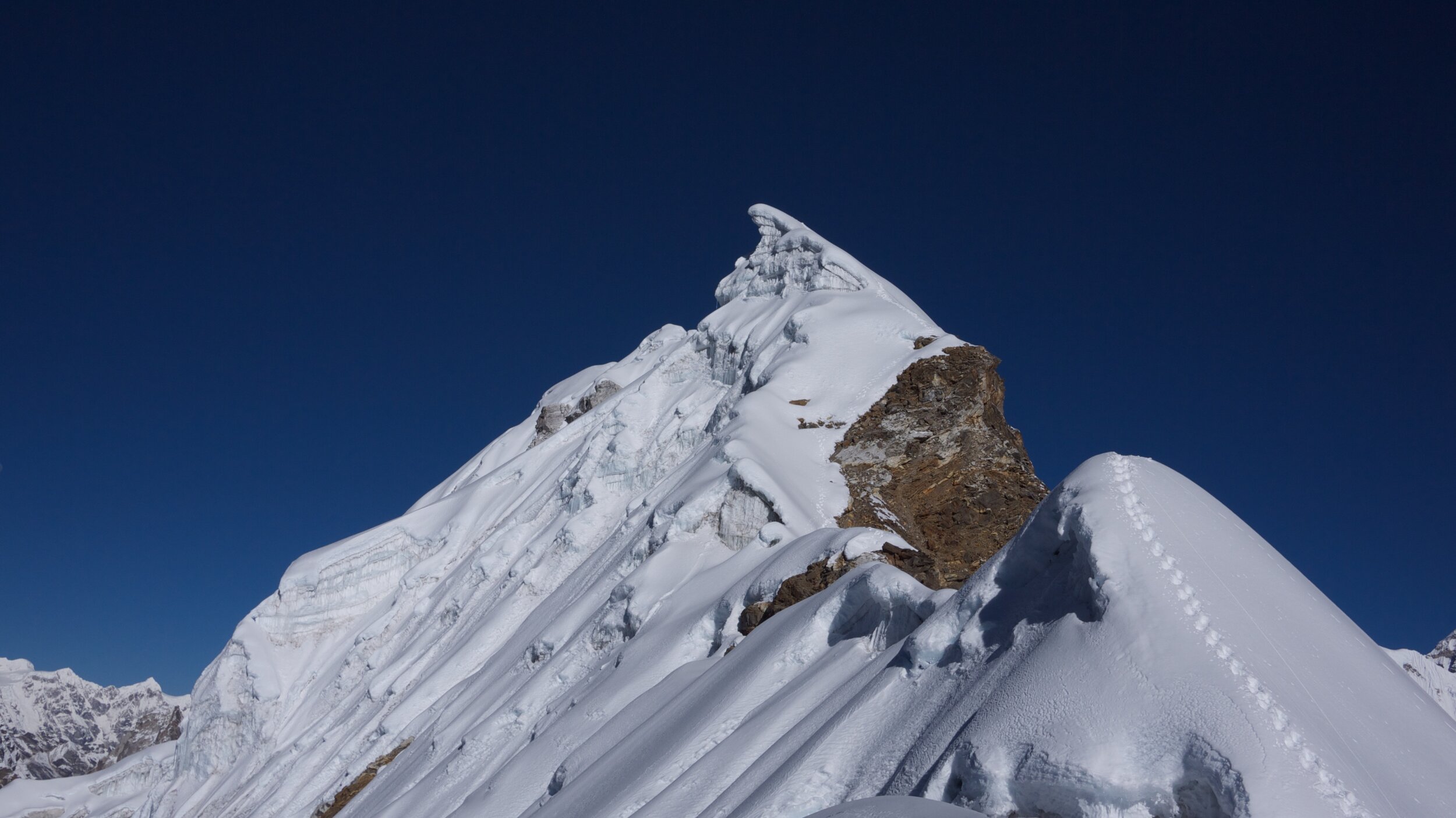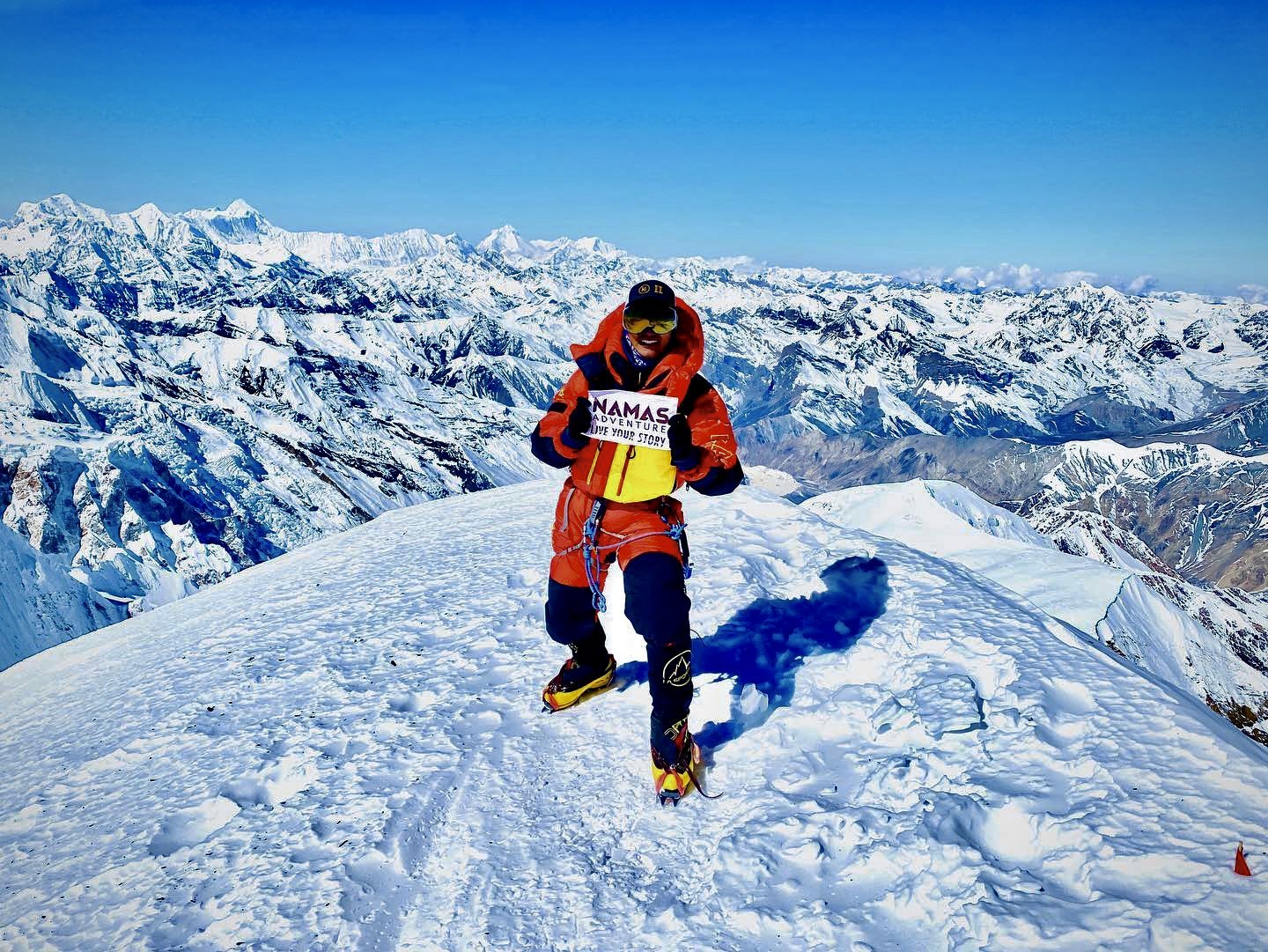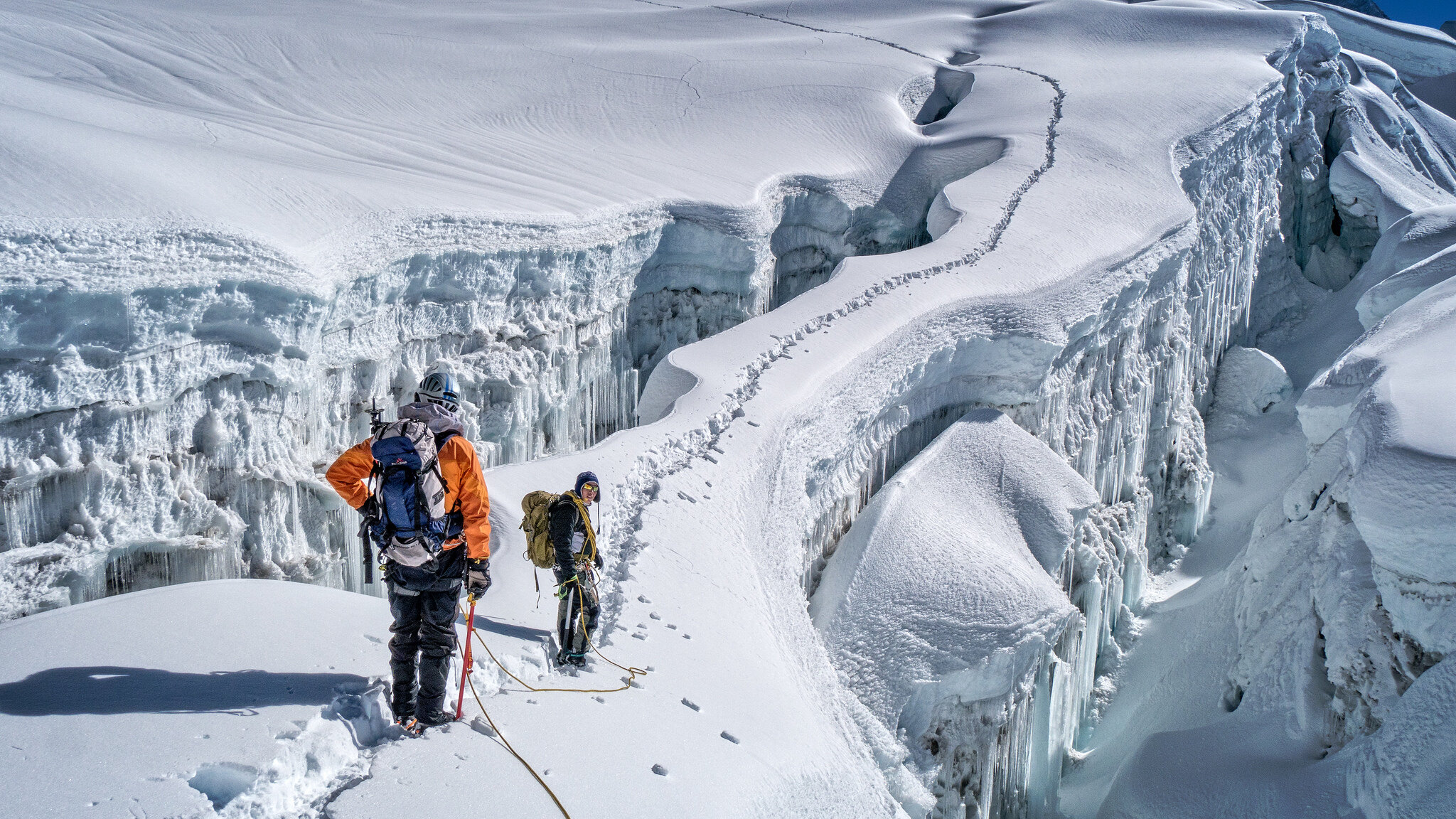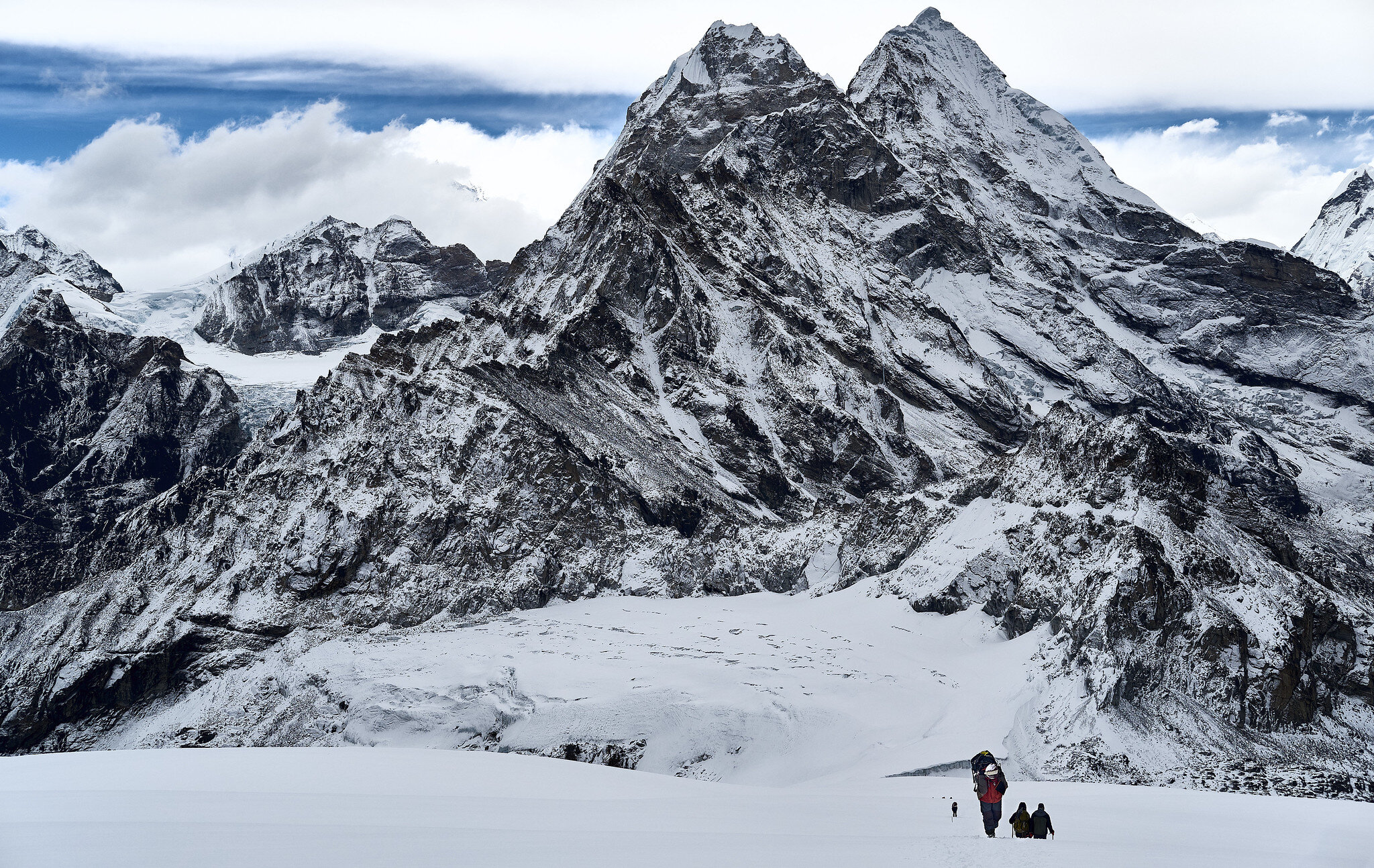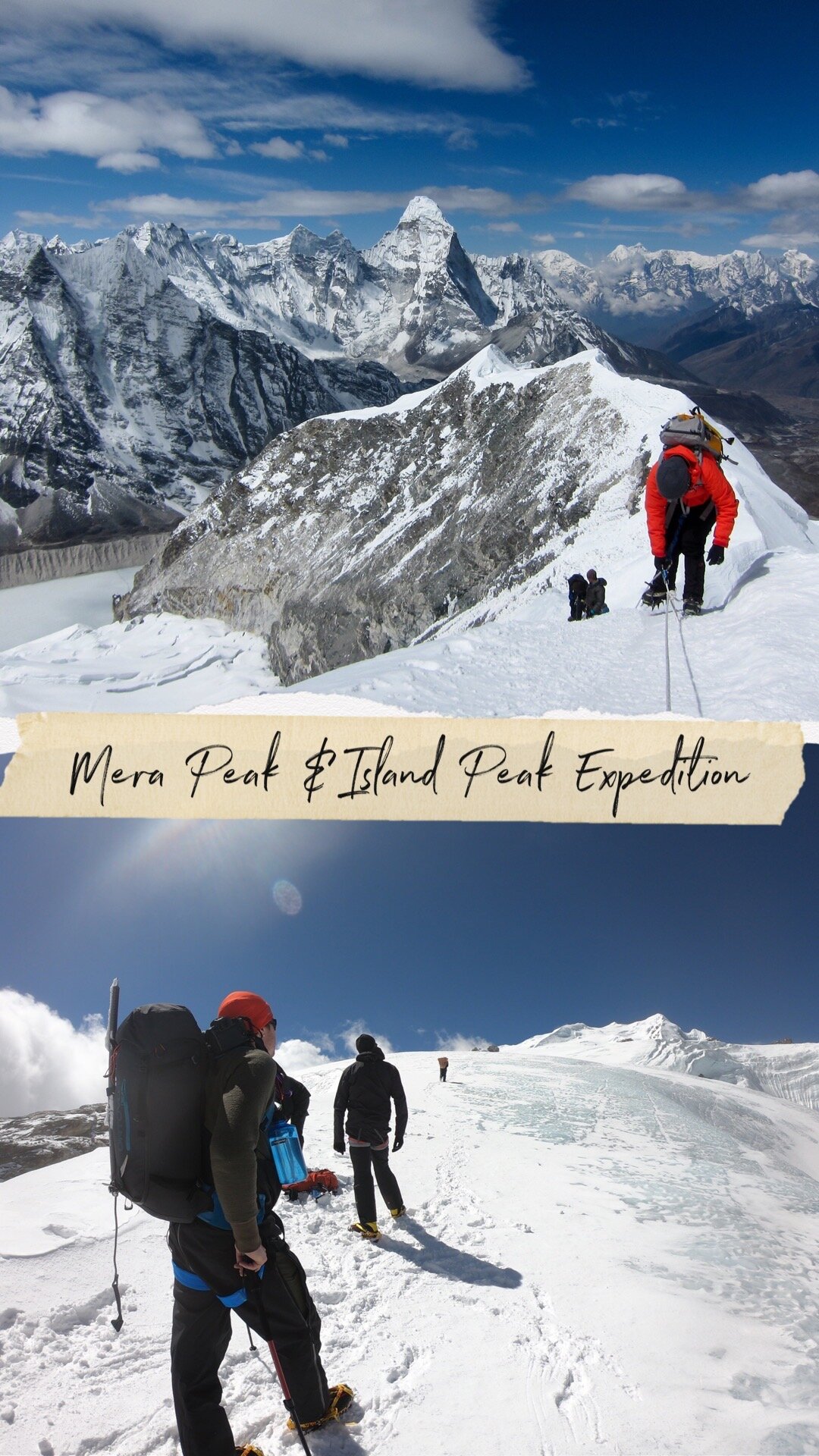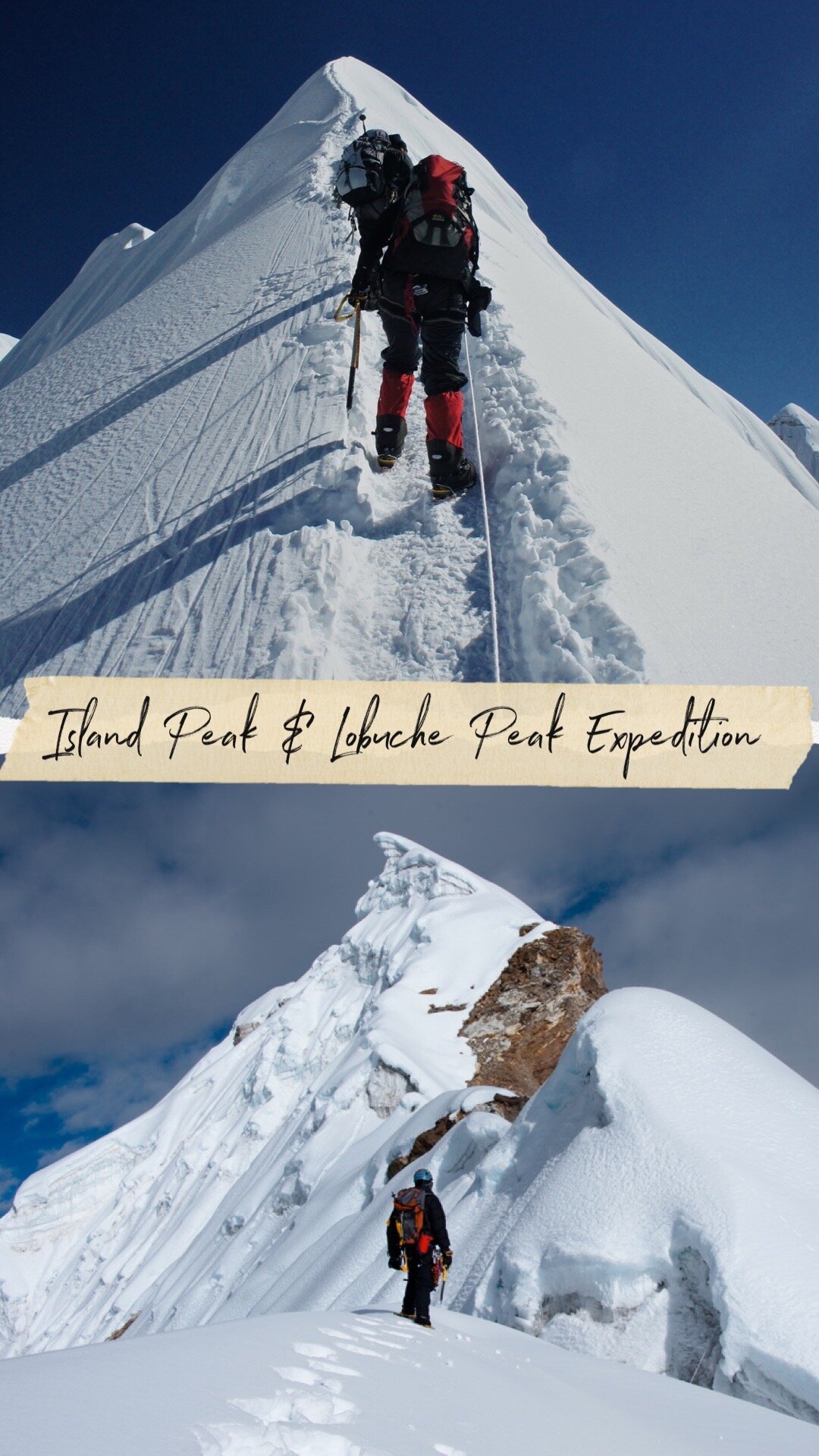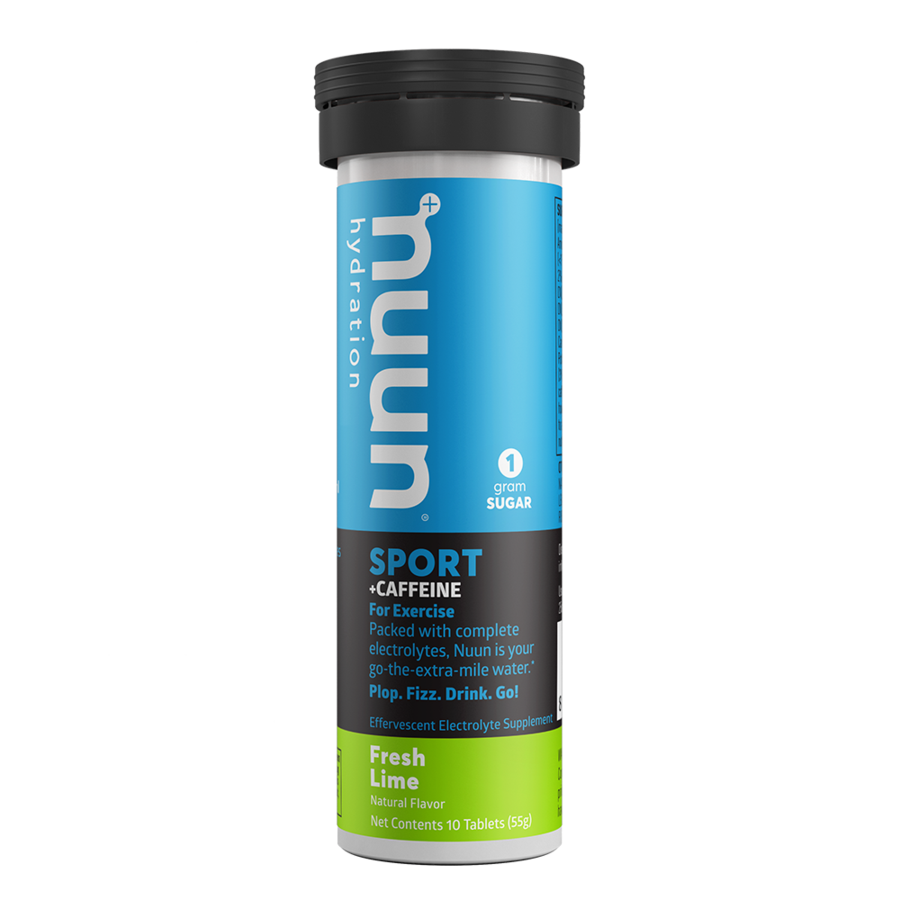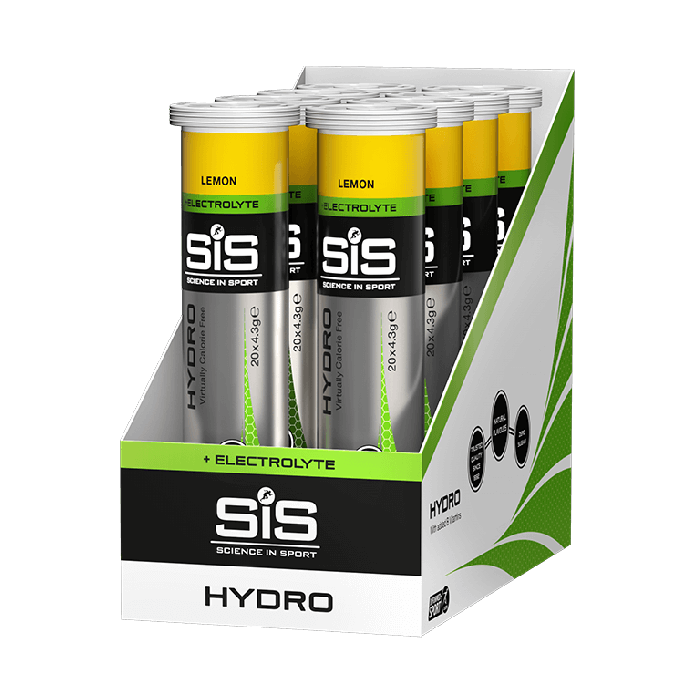Mera Peak Ski Expedition. New possibilities in the Himalayas - Namas Adventure
Mera Peak Ski Expedition. New possibilities in the Himalayas
Mera Peak has been attracting high-altitude ski lovers and we can understand why. Although ski adventure has yet to be a fully commercial adventure activity in Nepal, foreigners seeking high altitude ski thrill adventures have been navigating the slopes of the Himalayas. Nepal has some of the highest mountains in the world and all the ski enthusiasts must be wondering why does Nepal not already have ski facilities in place? Poor infrastructure and lack of knowledge in ski sport and business models have been a foreign thing for Nepal.
But with changing time and the need for more adventure options rather than just climbing, ski sport has been gaining attention and particularly on the slopes of Mera peak. We would say it’s pretty high, wild and off-piste but that is what makes it attractive when planning a ski expedition in Nepal. Spring sees a lot of fresh snow which may make it an ideal condition to but the ones who have skied in the past, rather prefers planning skiing during autumn. With a good amount of both stable and fresh snow, skiing in autumn is much more enjoyable. We understand why Mera Peak attracts skiers as it has fewer objective hazards in normal climbing routes (i.e. crevasse, rock falls, avalanches) and the mountain has a wide section to climb or ski down making it much safer to ski compared to a narrow couloir. Our guide members who are not ski trained would always say that skiing down Mera would be so much fun and less tiring 😅. But yes ski Expedition in Mera is a new possibility adding new adventure activity in the Nepalese mountaineering scene. Nepal now has IFMGA certified ski-trained guides who can assist you in making the climb and shred down the slopes of Mera peak together. This will be one hell of an adventure for anyone planning their expedition. To top that up, you will be skiing down a peak higher than the whole of North America or Europe, how about that for a portfolio of mountains you have skied down. Skiers will have to be proficient and at least have 50+ hours of ski sessions with few high altitudes off-piste ski experiences.
Permits are a must ($1000 for 1 - 10 skiers) and an additional $100 per additional member. A separate Mera Peak climbing permit is also needed. Want to plan your next high-altitude ski expedition in Nepal? Email us at bookings@namasadventure.com to plan your adventure and our team will be more than happy to assist you and help achieve the Mera Peak 6476M summit and safely ski down Mera Peak.
Go dare great things. Live your story.
Everything you need to know about Mera Peak 6476M climb - Namas Adventure
Summit of MeraCancel Peak 6476M
Everything you need to know about Mera Peak 6476M climb
Mera Peak is one of the best climbing peaks suitable for all beginner/novice climbers. Even if you are an experienced climber who wants to enjoy a decent climbing holiday, then Mera peak still is a good choice. Located in Makalu Barun Valley, this peak offers one of the most perfect remote adventure holiday experiences. Trekking through the remote villages, rugged trail paths up and down the hills, through forest trails and of course beautiful mountains all around.
But before you embark on one of the most amazing adventures, we have listed 11 useful informations that will help you prepare for your Mera peak climbing expedition.
1. When is the best time to climb Mera Peak?
Mera Peak is best suited to climb during two climbing seasons. Spring (March-May) and Autumn (September - November). During both the season there aren’t as many climbers as other peaks such as Island Peak. So climbers can expect a low-medium number of climbers.
For experienced climbers, winter climb is still possible but this comes with a lot of uncertainties. i.e unstable conditions, tea houses may not be operational or even the ones operating won’t be well-stocked. Pre-arrangements will have to be made but that will also depend on the number of climbers.
2. Is it possible to shorten Mera Peak climb?
Mera peak climbing can definitely be shortened but this comes at an additional cost. At Namas adventure, we do provide these services for private client groups ( 2+ members). The shortest Itinerary we can make it up to is 10 days Itinerary. Extra charges apply of an additional $4000 - $4500 applies since we will have to charter helicopter services. Please contact our team for other flexible options.
3. How much does it cost to climb Mera Peak? What does the cost include?
With Namas Adventure, Mera Peak costs $3650/£2850/€3300 per person. We provide premium high-quality all-inclusive peak climbing services. Climbers do not have to worry about anything with our team and totally focus on their climbing holiday and fun times ahead.
List of what’s included in your booking.
NMA Certified Sherpa Mountain guide
$300 Individual tip pool. Tip pool will be fairly distributed among all Namas staff members. (Guides, porters, drivers, hotel security, and staff). Guest may personally hand in extra tips to our guides and porters.
Namas Branded merchandise (Down Jacket, Cap, Buff)
1:2 Sherpa Guide: Client ratio
Cook and helping team at Base Camp and High Camp
35Kgs per person
Arrival hotel in Kathmandu
All trekking and climbing permits (Khumbu Region Permit and TIMS)
All internal-local transportation to and from the trekking trailhead
Breakfast, Lunch, and Dinner on trek and expedition days.
1 Pot of hot water every night
Hydration tablet, frozen foods at BC and high camps
Lodge accommodation during the trek
Porters
Arrival pick up and departure
Internal flights
Basic First aid kit
Welcome/Farewell leave Dinner
4. Are guides necessary for Mera Peak?
To issue a permit for Mera Peak climb, you will have to go through a registered local company, for this purpose guides are hired. For beginner to intermediate climbers, we highly suggest climbing the peak with guides. The usual climbing route does have a crevasse and new hazards may appear every climbing season. Experienced climbers/guides who want to venture into new routes will still have to be assigned a local guide even if they don’t prefer them climbing with them. So, yes legally speaking guide assistance is required.
5. What is the best acclimatisation itinerary for Mera Peak climb?
On high altitude climbing trips like Mera Peak climbing expedition, it’s imperative that climbers acclimatize properly so that the body is well-rested, adapted, and stronger to climb even higher. With years of climbing -guiding experiences and well-known scientific literature, we know that our bodies need an adequate acclimatization period to adapt to the environment after gaining a certain elevation. With that knowledge and experience, our team has built up the following Mera Peak Itinerary.
On Mera Peak climbing trip, we make sure your itinerary has both Mera Peak base camp and high camp. Your body needs these adaptation periods when you are above 5000M+. This way you can experience alpine camping, enjoy the Himalayas all around you, and had gain enough strength to make your summit climb.
6. What training required to climb Mera Peak? Can you suggest me a training plan?
Mera Peak is by no means an easy climb even though we grade it as a beginner’s climb. Mountains are graded based on their technical and physical difficulties. For your training, we highly recommend climbers to focus on endurance and strength training. Any type of aerobic exercise, like long-distance running (10-15km) 3 to 4 times a week, cycling (1 hour - 2 hours), hiking gaining elevation with 10-15kgs weights on are some of the suggested training. More on our training mountain expedition blog.
Courses like beginner mountaineering classes are also a helpful tool. You will learn technical skills like climbing with a rope on 5/6 anchor points using ascenders, how to walk with crampons on ice, snow, and rock, and to be efficient with abseiling and overall gear safety checks awareness.
7. How hard is Mera Peak climb?
Mera peak is graded at 1B. (Alpine grading link).
If you are physically fit, then the final 2 days of your climb are the most difficult sections. Breathing is always a challenge at high altitudes but with proper acclimatization done ahead of time, staying well hydrated, eating properly, your body should recover and adapt to the altitude. Once you depart from Mera Base camp the real alpine challenge begins, mostly climbing on steep ice and snow surfaces. You will be walking for 4-6 hours to reach high camp. Summit day climb starts early (3 or 4 am) with the goal to reach the summit or near to the summit by sunrise. This will be the most challenging and rewarding part of the climb. You can expect to hike around 10+ hours on this day as you will have to summit and then descend back to Khare village. All your previous physical training, your will, mental strength, and your grit for real adventure will take you through this final day and to the Summit.
8. What are the clothing and gears - boots required for Mera Peak climb (trekking and mountaineering)? Can I rent gears for Mera Peak climb?
Choosing the right gear is very important. We advise climbers not to make compromises on the quality of gears and clothing, and to pay attention to layer up comfortably as well. You will highly depend on your clothes to keep you warm, especially during nighttime when temperatures can go down to -10/-15. Please check our equipment blog for recommended clothing and gears.
Renting your gears in Nepal? We provide gear rentals exclusively for Namas Adventure clients during our climbs. All the gears are in the best condition, clean, and highest quality. Kailas equipment provides all-out mountaineering gears. (Namas Equipment hire link)
If you want to hire it from other local sources in Nepal, our simple answer is NO. This is one of the most frequently asked questions mainly by beginner climbers. We have tested and tried several gears in Nepal and frankly, we do not recommend hiring here. We know it might seem like a huge amount of expenses to buy all the gears, but they are well worth it.
Boots (trekking and mountaineering) for Mera Peak
With better technologies, climbing shoes have improved every year. We highly recommend double-layered boots like La Sport G2Sm or Scarpa phantom. It is wise to spend on good mountaineering boots, as so with all the gears that we have mentioned in this post above.
9. What types of foods are available during Mera Peak climb? Is clean water available and how much water intake is recommended?
We suggest all our clients drink 4-6 l of water every day. Staying hydrated will also help you with acclimatizing properly. It’s best to take hydration tablets or filtration bottles with you.
Most of the foods are prepared in the tea houses and during your climbing days, kitchen tents are set up by our Sherpa teams. You do not need to worry about food but remember to eat enough. In the high altitudes, your body will naturally want to reject food or avoid using energy on anything, which includes eating too. You might have to force yourself with the first few couple of bites and then eventually your body will start accepting the food. We also provide packed dried meals, so that clients have other options should they not want to eat what’s being cooked in the tents.
Remember to avoid smoking and any alcohol intake. You might see our guiding leaders smoking or drinking but remember they are professionals and they have adapted very well to these environments compared to the climbers who go there just for adventure holidays.
10. What trip insurance will I need for Mera Peak climb? Do I need helicopter evacuation to be included in my insurance cover?
No matter how prepared you are, you never know when or how things might go wrong. You might be sick suddenly or not that we wish but there might be some incident, you might suffer from altitude sickness or anything we can’t imagine yet. So, for these reasons, it is always good to have insurance cover. Our recommended Insurance companies (link)
Helicopter evacuation is our final emergency option and we do recommend you have one in your insurance, as it is the only means of transport in the Everest region. Our guides will assess your condition and examine if it is a major issue. If not, they will use their experience to motivate and push you through your trip. However, in case of emergency, helicopter evacuation will be called upon.
There is a procedure to follow when calling for emergency evacuation. We will call the insurance company hotline, get approval with your insurance and only then helicopters are sent to the distress call location. You will have to pay for the evacuation in Nepal from your own pocket but once you are back home you can claim your money back. Make sure you collect helicopter evacuation receipts, certified doctor’s approval letter. The insurance company will ask for this evidence to back up your claim. There was a huge helicopter scam in Nepal during 2018, so insurance companies are taking extra measures to stop this from happening. Our guides and staff members in Kathmandu will also remind you of this process during briefings.
11. Which other high-altitude peak climbing can I aim for after Mera Peak climb? Can I combine other 6000M+ peaks with Mera Peak climb?
If you want to extend your trip and combine other 6000M peaks along with Mera peak, then we would like to recommend the following two other itineraries.
Mera Peak and Island Peak climbing
Island Peak is another 6100+ M peak that includes some technical climbing sections compared to Mera peak. To reach Island peak after Mera Peak climbers will have to climb via Amphu Laptsa Pass 5845M and then descend to Imja valley. Island peak is also known as Imja Tse peak (Local name).
Island Peak 6189M
This expedition program is the holy grail and the best possible introduction to Himalayan climbing - we ascend three beautiful 20,000 foot (6000+ meter) peaks which is one of the most spectacular settings in the world. Join this trip for great trekking, a rewarding cultural experience with the Sherpa people, and a challenging feat on climbing on Mera Peak (6,476M), Island Peak (6189M), Lobuche East (6119M).
Once you have completed your Mera Peak climb and when you feel like you want to take on higher peaks we can suggest other 7000M+ - 8000M+ peaks that you can aim for. Baruntse Peak Expedition 7129M, Himlung Himal Expedition 7126M or Manaslu Expedition 8163M.
Baruntse Base Camp 5300M
Mera Peak is one of the most exhilarating adventure of a lifetime. Like every other mountain climbing trip this is a worthwhile adventure. We hope the information we have provided above will help you decide/prepare in the best way before you embark on your Mera Peak climbing expedition. If you are looking for a great climbing trip and have an amazing time in Nepal then we would love to have you onboard for our Mera Peak climbing trip. You can be assured that you are provided quality services with our fun-loving yet professional guides who have 5 - 10+ years of taking clients on such peak climbing trips. After all we do aim to be the best adventure specialist in the world and you having a great time, being safe and summiting will always be our priority.
If you do have any more questions, please ask us below in the comment section or you can email us at bookings@namasadventure.com and our team will get back to you as soon as they can. Stay well. Challenge yourself. Dare great things and live your story.
Climb - Mera Peak link
Himlung Himal 7126M Expedition strategy - Namas Adventure
Himlung Himal 7126M Expedition Strategy
Himlung Himal (7126M) is one of the most accessible peaks in the Himalayas (Nepal). Located just between North of Manaslu 8163M and the Annapurna Himalayan range, Himlung is a peak for any mountaineering enthusiast looking to climb a 7000M peak that is remotely situated and provides all the aspects of challenging mountaineering adventure. As we prepare to plan for this expedition from 2021 onwards, we want to share our climbing strategy which was pioneered by Paulo Grobel along with Nepalese guides, paving expedition strategy routes (safer/enjoyable) for future climbers. If you are looking for an amazing time in the Himalayas, do join our expedition. Another amazing 7000M peak to consider is Baruntse Peak expedition.
Base Camp to Camp 1 (Co-ordinates: N 28° 45 384 E 84° 22 147)
The new base camp also called ‘French base camp’ is comfortable, with water nearby and sheltered from avalanches. The logistical challenge remains to pitch the camp as it seems a bit complex when crossing through the Pangir Glacier on big inconvenient boulders and the way up the moraine on the right bank is exposed to rockfall.
Our strategy will be to conduct 2 rotations between BC- Camp 1 and Camp 2 (weather conditions permitting) and then summit push from camp 2. Note - Camp 3 is an alternative solution but due to its risky nature, the lead guide will only strategize camp 3, if needed after assessing the situations in the mountain while on expedition.
Camp 1 6000M to Camp 2, 6200M (2X rotations target)
Access to Base Camp from Camp 1, is quite simple and very quick (2 to 3 hours) on a trekking terrain, with moraines and small valleys. The snow conditions may alter the progression, of course, but there is no slope subject to avalanches on the way up.
From Camp 1 heading on to camp 2, then traverse across a perched scree slope that leads to the side of the glacier. Following the side of the glacier (crevasses and disturbed terrain, rocks, and snow) until climbers can stand up on the flatter glacier, with big steps; a few twists and turns are needed. Depending on the season and the snow conditions, this part represents the trickiest part of the ascent. We continue up on the glacier, avoiding a few crevasses. We find suitable terrains to set up our camp on the ‘Glacier Camp’. It is pleasant and vast enough to welcome several groups. It seems subject to little, if any, risk of avalanche (to be verified depending on conditions). We climb with ropes attached together on the glacier, which shows little danger of falling into crevasses.
Camp 2, 6200M - Camp 3 (Optional)
Camp 3 is only a short distance (1 hour) away from camp 2. Heading to Camp 3 from Camp 2 is a comfortable reach, we climb by continuing up on the icy escarpment up to the last place before the ridge (a few ups and downs). Camp 3 remains an option due to its risky nature of being on the ridge. Guide members will only decide after inspecting/discussing amongst themselves whether camp 3 is safe and actually required. (to be double-checked under exceptional snow conditions).
Camp 2, 6200M - Summit 7126M - Camp 2 or 1
Final ridge to Himlung Summit.
The climb is long and cannot be reduced with an additional high camp. The first part of the ascent consists of reaching the pass across snowy slopes, a little bit steep (30°) and exposed. Fixed ropes are often installed by the lead guide and once we are past that, then the slopes become less steep, with a few flat bits.
After the crevasse opening, which is generally not a problem, the slope on the side of the ridge becomes steeper. This is the steepest part of the whole climb: about 400m at 30/35°. In hard/frozen snow conditions, there is a high risk of falling, so we install fixed ropes on this part as well. The route then reaches a less steep ridge, up to a flatter section before the small final slope.
After the summit, we descend down to camp 2 or camp 1. Then the next day we head to base camp, pack all our gears and celebrate our summit success, reflect and have a more joyous night, and prepare for the next day’s journey towards Kathmandu and thus ending our trip.
If you do have any more questions or want to join our yearly spring or fall Himlung Himal expeditions then please ask us below in the comment section or you can email us at bookings@namasadventure.com and our team will get back to you as soon as we can.
Stay well. Challenge yourself. Dare great things. Live your story.
More route reference: Paulo Grobel
Everything you need to know about Island Peak climbing - Namas Adventure
Everything you need to know about
Island Peak 6189M climb
Planning on climbing Island Peak 6189M?
Here is everything you need to know about climbing this most popular 6000M+ peak in Nepal. Since 2016 we have been leading climbing groups to Island Peak and with our suggestions, our clients have been successfully able to enjoy while achieving their summit success.
Photo by - Brad
1) When is the best time to climb Island Peak?
For most climbers, Island Peak is best suited to climb during Spring (March-May) or Autumn (Mid-September - October) on any given year. The weather during these times in the Himalayan region and most of the places in Nepal remains stable, which is perfect for adventure activities. Spring season is chosen for most of the 8000+M expeditions in the Everest region, so you can expect trekkers’ crowd on the trails. However, once you reach your Island peak camping site, you can see the numbers dropping down drastically as the majority of the people on the trails are there for trekking.
Winter climbing is still possible, but we recommend this for individuals with a vast amount of mountaineering experiences, almost at the pro athletes’ level. Temperature is very low and weather conditions are harsh. It can be down to -25/-30 C and winds can pick up to 60mph+.
2) Are guides necessary for Island Peak?
Without the help of Sherpa guiding leaders, we do not recommend climbing in the Himalayas, unless you are a mountain guide yourself. You will have to walk through support ladders with crampons on while crossing the crevasse openings. The final climb to the summit is a 90-degree vertical climb where you will have to use ascenders to climb all the way up to the summit. Climbing a peak is not just about reaching the summit. You also need to consider the effort on descending back safely which can be equally exhausting as this requires your full focus as well. You will have to use atc or figure 8 gears to descend below from the peak.
We do collect mandatory pre-tour tips, which include summit bonus, tips to all the staff members involved in your climbing, porters, assistant guides, airport pickup/drop off drivers, and hotel helpers/securities. We fairly distribute these tips based on the type and amount of work each member has performed. Additionally, if our guests want to make extra personal tips, then they are more than welcome to do so.
3) What is the best acclimatisation itinerary for Island Peak climb?
When we want to commit to climbing adventure at a high altitude, slow and steady is the right way. Our itineraries have been refined and designed by our guides with years of climbing and guiding experiences. What we have found in general is that our bodies need an adequate acclimatization period to adapt to the environment after gaining a certain elevation.
On Island Peak climbing particularly, we highly suggest taking 2 days of acclimatization at Namche Bazar and an additional 2 Days stop at Dingboche. We then make sure your itinerary has both Island Peak base camp and Island Peak high camp afterward. Your body needs these adaptation periods when you are above 5000M. This way you can experience alpine camping, enjoy the Himalayas all around you, and had gained enough strength to make your final climb.
4) What training is required to climb Island Peak? Can you suggest me a training plan?
Island Peak is by no means an easy climb although we grade it as a beginner’s climb. Mountains are graded based on its technical and physical difficulties. For your training, it is very hard to mimic walking on ladders like the ones you will come across when crossing the crevasse. We highly recommend focusing on endurance and strength training. Any type of aerobic exercise, like long-distance running (10-15km) 3 to 4 times a week, cycling (1 hour - 2 hours), hiking gaining elevation with 10-15kgs weights on are some of the suggested training. More on our training mountain expedition blog.
Courses like beginner mountaineering classes are also a helpful tools. You will learn technical skills like climbing with a rope on 5/6 anchor points using ascenders, how to walk with crampons on ice, snow, and rock, and to be efficient with abseiling and overall gear safety checks awareness. Beginner Ice climbing alone is another course that will help you with all the required skills.
Photo by jemappelleguillaume(flickr)
5) How hard is Island Peak climb?
Island peak is graded at 2B in difficulty. (Alpine grading link).
If you are physically fit, then the final 2 days of your climb are the most difficult sections. Breathing is hard but with proper acclimatization done ahead of time and by staying well hydrated and consuming enough nutrition, you should be able to cope with the altitude. When you finally come across the vertical wall, this will be your final challenge. On top of that, you will be walking for 4-5 hours by the time you reach at this point. All your previous training of endurance and strength training should have prepared your body to face those challenges.
6) What are the clothing and gears - boots required for Island Peak climb (trekking and mountaineering)? Can I rent gears for Island Peak climb?
Choosing the right gear is very important. We advise climbers not to make compromises on the quality of gears and clothing, and to pay attention to layer up comfortably as well. You will depend highly on your clothes to keep you warm enough for the dropping temperatures at nighttime which can go down to -10/-15. Please check our equipment blog for recommended clothing and gear.
Renting your gears in Nepal? The simple answer is NO. This is one of the most frequently asked questions mainly by beginner climbers. We have tested and tried several gears in Nepal and frankly, we do not recommend hiring here. We know it might seem like a huge amount of expenses to buy all the gears, but they are well worth it. You can even hire from the city you live in. Make sure they are the original products from well-known adventure gear companies. (North face, Mountain hardware, Kailas, etc.)
Boots (trekking and mountaineering) for Island Peak
With better technologies, climbing shoes have improved every year. We highly recommend double-layered boots like La Sport G2Sm or Scarpa phantom. It is wise to spend on good mountaineering boots, as so with all the gears that we have mentioned in this post above.
7) What types of foods are available during Island Peak climb? Is clean water available and how much water intake is recommended?
We suggest all our clients drink 4-6 l of water every day. Staying hydrated will also help you with acclimatizing properly. It’s best to take hydration tablets or filtration bottles with you.
Most of the foods are prepared in the tea houses and during your climbing days, kitchen tents are set up by our Sherpa teams. You do not need to worry about food but remember to eat enough. In the high altitudes, although the weather is extremely cold, your body will naturally want to reject food or avoid using energy on anything, which includes eating too. You might have to force yourself with the first few couples of bites and then eventually your body will start accepting the food. We also provide packed dried meals, so that clients have other options should they not want to eat what’s being cooked in the tents.
Remember to avoid smoking and any alcohol intake. You might see our guiding leaders smoking or drinking but remember they are professionals and they have adapted very well to these environments compared to the climbers who go there just for adventure holidays.
8. How long do climbers hike or climb every day?
On usual trekking days, you will be walking for 5 - 6 hours a day covering 10km - 14 km. But on the summit day, your climb could last up to 8 - 9 hours since it is advised to go as slow as possible, using the right amount of energy for the long duration and inhaling as much air as possible.
9. Everest base camp tips
Island Peak itinerary falls right in the middle of the Everest base camp trek. That’s why we have chosen to have it on our itinerary so that climbers can visit this iconic Everest base camp and see the great Khumbu icefall, the doorway to Everest climbing. See more on our blogs about Everest base camp tips.
10. What trip insurance will I need for Island Peak climb? Do I need helicopter evacuation to be included in my insurance cover?
No matter how prepared you are, you never know when or how things might go wrong. You might be sick suddenly or not that we wish but there might be some incident, you might suffer from altitude sickness or anything we can’t imagine yet. So, for these reasons, it is always good to have insurance cover. Our recommended Insurance companies (link)
Photo by - fwarrenphinney
Helicopter evacuation is our final emergency option and we do recommend you have one in your insurance, as it is the only means of transport in the Everest region. Our guides will assess your condition and examine if it is a major issue. If not, they will use their experience to motivate and push you through your trip. However, in case of emergency, helicopter evacuation will be called upon.
There is a procedure to follow when calling for emergency evacuation. We will call the insurance company hotline, get approval with your insurance, and only then helicopters are sent to the distress call location. You will have to pay for the evacuation in Nepal from your own pocket but once you are back home you can claim your money back. Make sure you collect helicopter evacuation receipts, certified doctor’s approval letter. The insurance company will ask for this evidence to back up your claim. There was a huge helicopter scam in Nepal in 2018, so insurance companies are taking extra measures to stop this from happening. Our guides and staff members in Kathmandu will also remind you of this process during briefings.
11. Which other high-altitude peak climbing can I aim for after Island Peak climb? Can I combine other 6000M+ peaks with Island Peak climb?
If you want to extend your trip and combine other 6000 M peaks along with Island peak, then we would like to recommend the following two other itineraries.
This itinerary takes you through the highest trekking Peak Mera 6476 M and then down to cross Amphu Lapsta pass. The route takes you down towards Barun valley where Baruntse Peak 7129 M peaks stand tall and towards Mera Peak, the highest trekking Peak in Nepal.
Island Peak with Lobuche Peak climbing
Lobuche Peak is another 6100+ M peak that is often used by Everest summit climbers as acclimatization peaks. The peak is just two camps away from Island Peak and is a great combination should you want to take upon two peaks at once.
This expedition program is the holy grail and the best possible introduction to Himalayan climbing - we ascend three beautiful 20,000 foot (6000+ meter) peaks which is one of the most spectacular settings in the world. Join this trip for great trekking, a rewarding cultural experience with the Sherpa people, and a challenging feat on climbing on Mera Peak (6,476M), Island Peak (6189M), Lobuche East (6119M).
If you want to aim higher after Island Peak towards 7000M+ peaks then Baruntse 7129 M, Himlung Himal 7126 M are some of the peaks climbing we would recommend. Just climbing Island peak won’t be enough, we suggest you climb more different technical and non-technical peaks in Europe around the alps if possible. Amadablam Expedition is another super technical and tough mountain we would like to recommend but you will have to be extremely great with your mixed climbing skills and be fit both mentally and physically.
If you are planning to climb Island Peak in any given year, we run climbing trips every year during Spring and Autumn.
Please click the link to be directed to Island Peak Expedition page.
If you do have any more questions, please ask us below in the comment section or you can email us at bookings@namasadventure.com and our team will get back to you as soon as they can.
Stay well. Challenge yourself. Dare great things and live your story.
Namas Adventure team
5 Things to know about Mera Peak climb - Namas Adventure
Descending down Mera Peak Summit
5 things to know about Mera Peak climbing
When is the best time to trek/climb Mera Peak?
March-May ( Spring ) and September - November (Autumn) is the best time to trek/climb Mera Peak.
Is Mera Peak suitable for beginner climbers and what kind of fitness do I need?
Yes, Mera Peak is a non-technical high-altitude trekking peak. To reach summit 6476M you do not need any special climbing skills with ropes, gears, and use of an ice axe. Mera Peak is a very popular destination for clients with little or no mountaineering experience. The mountain has fewer to non-technical challenges, there are 3-4 small opening crevasses during the climb but apart from that, the climb is straightforward. All climbers are recommended to partake in preparative fitness and altitude training before attempting an ascent. You should be able to carry 5-8 kgs of your bag pack, walk up and downhill every day for 15/16 days and be able to push yourself during the summit climb.
Physically for beginners, Mera Peak can be demanding. We highly suggest you train yourself well over 6 - 4 months before your trip. You will need good endurance and body strength. Aerobic exercises mixing with overall body strength-building routines should help you prepare physically for your trip.
Can I see Mt. Everest from Mera Peak?
From the summit, five 8,000m peaks are visible: Mount Everest, Lhotse, Cho Oyu, Makalu, and Kangchenjunga, as well as many other Himalayan peaks. The standard route from the north involves high-altitude glacier walking. The west and south faces of the peak offer more difficult technical routes.
How hard is it to climb to the summit of Mera Peak?
Mera Peak is classed as 1B alpine grade. When it comes to an expedition the more fitter and stronger you are, the better your chances of successfully climbing to the summit and most of all enjoying the expedition. Summiting Mera Peak mostly depends on the weather condition and your fitness level. The climb normally starts around 3/4 am in the morning and it is about 3-4 hours climb to the summit. For any climbers it is a technically straightforward ascent, the main hurdle being proper acclimatization to the high altitude.
Which Mountain can I aim for after Mera Peak that’s above 6500M?
If you have got time and you are feeling extra adventurous then you can either Mix Mera Peak with Island Peak, which takes you through a beautiful and challenging Amphu Lapsta pass. On the way, you will also come across Baruntse 7129M and Makalu 8481M. Or you can simply take on our challenge of three 6000M+ Peak expeditions. (Mera, Island and Lobuche East) Peaks (Click for expedition Link)
Our main suggestion is to take it one step at a time. The lure of Everest is there but taking small steps, gaining the right experience, and understanding your physiology is very crucial for climbing higher mountains. Amadablam 6810M, Baruntse Peak 7129M, Manaslu 8163M, Tilicho Peak 7134M are some of the 7000M+ - 8000M+ Peak expedition we operate and organize at Namas adventure.
If you do have any more questions, please ask us below in the comment section or you can email us at bookings@namasadventure.com and our team will get back to you as soon as they can.
Stay well. Challenge yourself. Dare great things and live your story.
Nutrition for Mountain climbing - Namas Adventure
NUTRITION FOR MOUNTAIN CLIMBING
Image- Namas Adventure, Mera Peak summit
Climbing high altitude mountains for both sports and recreational purposes is an immense physical challenge. Altitudes above 4000M to 5000 M are considered high altitudes and 5000M above are considered extreme altitudes. You have to be physically, psychologically, and mentally prepared. Preparing yourself by exercising and practicing techniques, getting the right gears are important parts of mountain climbing. However, to be able to make yourself stronger during training and climbing days getting the right nutrition is very important. Did you know that taking the right diet can improve your effort ability by 20% overall? It is easier said than done but when it comes to mountains and high altitude you might want to dedicate yourself to this regime of the right amount of exercise to make you physically fit and eating well. The right nutrition is another factor in your performance.
“ Did you know that taking the right diet can improve your effort ability by 20% overall”
Image by - Brad
Research has shown that when climbing high altitude mountains climbers can burn anywhere from 6000 - 10,000 calories per day. Losing weight is very normal and you will have to gain your strength back quickly. Your digestive system won’t work the same way as it does at a lower altitude. Your system will want to reject food as it does not want to put in much effort and forcing yourself to eat is necessary. Carbohydrate (carbs) is your best friend when it comes to nutritional value but also do not forget the proteins and fats. You will have to snack a lot with easy-to-absorb carbs, hydrate often, during your climbing hours, and when you rest during dinner at your camps more carbs and proteins. Fill up that glucose in your body as it stores fats in your body which your body will use when needed or during the hard push.
“60% - 70% of your meal nutrition should be carbs, 20-30% proteins and 5% - 10% fats”
Recommendations
High carbohydrate foods - Rice or whole grain products, bread, pasta, fruits rich in natural sugar ( banana, oranges, blueberries, grapefruit, apple) sweet potatoes, potatoes, milk, Quinoa, kidney beans & chick peaks.
You can also pack dried frozen dried meals that are easily packable, 90% lighter, preserve the natural taste, gives you nutritional value. Easy to prepare, just pour boiling water, stir and wait about 10 minutes, and feast on it. This is highly practical as it makes logistical planning much easier. We recommend (LYO FOODS) they have some great options, especially for mountaineering.
Proteins sources mile & cheese, meats, tofu, eggs, lentils and seeds, and nuts.
Fats source dried meats, butter or ghee, chocolate, olives.
Keeping yourself hydrated throughout is very very important. You will sweat a lot, we recommend you to intake anywhere from 4l- 6l of water every day. Just drinking normal water is not enough. It is necessary to add hydrating tables with electrolytes in your water. Products recommended ( SIS hydration tablets, Nunu Hydration tablets )
Mini brunches when hiking/climbing for 6- 10+ hours is very crucial. Your body quickly burns all the nutrition within 2-3 hours and you will need to often replenish those nutrients. You will need foods that don’t have to be cooked, easily packable, and rich in nutrition. Bananas, chocolate, nuts& seeds, jerky or dried meat, hydration tablets, energy gels, and bars are highly recommended. Every night prepare it in a sealed bag or an area of your backpack where you can store and reach them easily. These superfoods will give you that much-needed energy, thus, you’ll feel active for a longer time.
I hope this article was helpful. It is very important that you pay attention to your diet nutrition especially during your climbing days. Remember to take in a lot of carbs during your trekking/expedition lunch or dinner time. Snack a lot, almost like a mini brunch every 2-3 hours, to give your body a constant flow of energy and stay hydrated (add hydrating tables) every time. I personally have suffered during my climbing days for not eating well or not staying properly hydrated. So I hope you can follow the suggestion and enjoy your climbing. During your trekking/expedition on all our itineraries, meals with these nutritional values are served at the lodges we rest or during camping. Extra food is always helpful. Please ask our team how much you will need to personally pack.
One more thing, do not intake any alcohol, especially during your climbing days. You will see Sherpas or porters who have always been climbing drink but you need to remember that their bodies have always been through this every year in and out. So comparing it won’t help, instead, save it for the last and enjoy your beer after your climbing is finished when you return to base camp or the nearest lodging area.
Also, please carry your waste with you all the time and dump them on your next village or lodging spot. Encourage your team not to litter the mountains as the waste might never be removed from these remote and pristine areas.
Keep exploring, eat well take on that challenge. Mountains are calling. Go live your story.
References -
https://lyofood.com/blogs/lyofood-blog/nutrition-at-high-altitude?welcome
https://www.healthline.com/nutrition/12-healthy-high-carb-foods
Written by - Bisesh





